
Flash Flood Warnings Issued For Majority of the Hudson Valley
As the brunt of what's left of Ida pushes through the region, the National Weather Service has issued multiple Flash Flood Warnings for all, but the northernmost counties of the Hudson Valley, and parts of the Catskills. Torrential rains continue to move up from the southeast, and are expected to last through the overnight, according to forecasts. Hudson Valley Weather says the heaviest rainfall is expected from around 7pm until a little after midnight late Wednesday into Thursday. This could easily lead to numerous street flooding across an area that's seen one of it's rainiest summers in years.
Ida's storms already dumped flooding rains and even spawned tornadoes throughout the Mid-Atlantic Wednesday afternoon. As the remnants continue moving up the east coast and through our neck of the woods, expect rainfall of 1 to 2 inches per hour, according to Hudson Valley Weather. Forecasters say 1 to 4 inches of rain has already fallen across parts of the area Wednesday, and additional heavy rain is to be expected. This, on top of the already saturated ground could cause localized flooding through early Thursday.
Hudson Valley Weather also says that wind could become a factor by Wednesday, with some gusts approaching 20 to 35 MPH. This will be nothing close to what the Gulf states endured when Ida roared ashore as a strong Category 4 hurricane late Sunday, but some stronger gusts could still bring down tree limbs and power lines late Wednesday evening. Most outlets, such as NBC, say that the tornado risk should stay mostly south, towards New Jersey, New York City, and Long Island. However parts of the Hudson Valley, especially Westchester and Rockland Counties, face a slighter risk of an isolated tornado Wednesday evening.
Tornadoes are known to form within hurricanes and tropical systems, particularly towards the southeastern side of the main storm's circulation, as we saw when the remnants of Fred sparked numerous tornado warnings across the Tri-State area in mid August.
TIPS: Here's how you can prepare for power outages
KEEP READING: What to do after a tornado strikes
LOOK: The most expensive weather and climate disasters in recent decades
More From WPDH-WPDA







